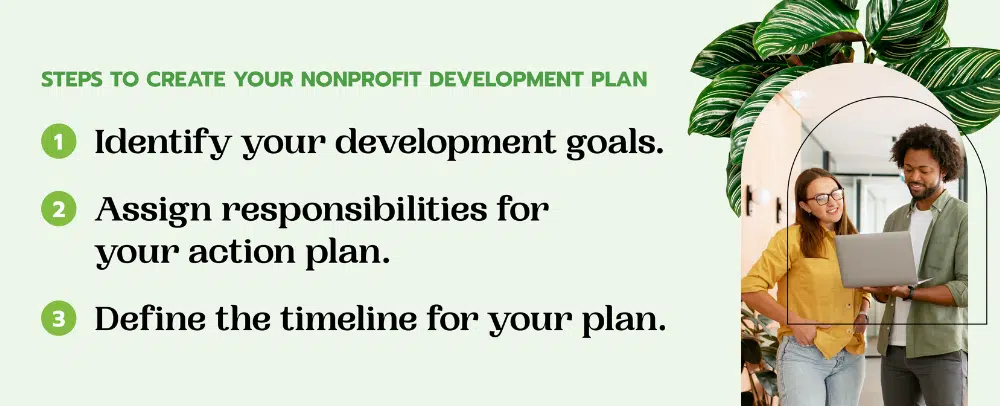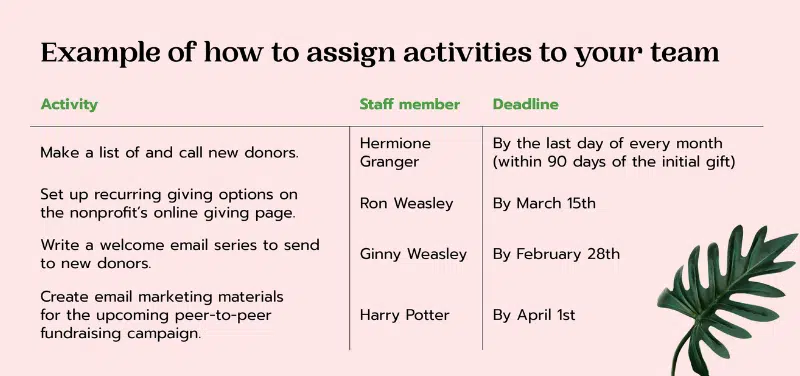Download our Free Nonprofit Development Plan template.
Your nonprofit has a lot on its plate. The ideas that are the most exciting are likely those pertaining to planning your mission and programming activities. That’s why you got involved with the organization in the first place!
However, another exciting portion of your activities will be planning out your development plan. This plan identifies the various fundraising opportunities and activities that you’ll execute throughout the year.
Why is this so exciting? These are the activities that power your programs that’ll help you ultimately achieve your mission. It’s the portion of your strategic plan that will help you grow your organization and create the most significant impact possible.
Going forward, your nonprofit should carefully and precisely define each element of your nonprofit development plan.
It’s often helpful to start with a template that can help you organize your data and plans. Luckily, we offer a template that you can use free of charge! Once you’ve downloaded that, you can start walking through the steps in this guide to fill it out.
Ready to create the best development plan possible for your nonprofit? Let’s get started.
1. Identify Your Development Goals
Before you can get started raising funds or even planning to raise funds, you need to establish some goals for your nonprofit’s development team.
Your development goals should be directly tied to and related to your philanthropic goals. For instance, if you want to create a new program at your organization, you should estimate the cost of developing that program and be sure that’s accounted for in your development goals.
Determine how much money you’ll need to raise to achieve your goals for philanthropy. Then, break that down into the fund acquisition channel. For instance, you might say that:
- 50% of your funds will be acquired through major donations.
- 15% of your funds will be acquired through grants.
- 20% of your funds will be acquired through your planned giving program.
- 10% of your funds will be acquired through your annual fund.
- 5% of your funds will be acquired through corporate giving programs.
With these percentages, you’ll know exactly how much you’ll need to raise through each fundraising category. Once you have these, you can break down your goals further into objectives.
Using the example above, if you want to raise $100,000 during the year and 50% of your funds will come from major donors. That means $50,000 will come from major donors. With this information, you can create a gift range chart necessary to raise these funds. Then, you can list out your prospects and generate cultivation plans, such as your stewardship events, meeting dates, and ask amounts.
Having your high-level plans, objectives, and actionable steps spelled out ahead of time will help guide your plan moving forward.
2. Assign Responsibilities for Your Action Plan
Now that you have your goals spelled out, you can start creating action plans to achieve those objectives and goals. We hinted at this step lightly during the last section. When you begin planning your stewardship event and meeting dates with major donors, you’re essentially starting to create your action plan.
You can also start planning out other activities that will help you achieve your goals and objectives, such as:
- Campaign timelines and types of campaigns
- Fundraising event schedules
- Stewardship plans and messages
- Marketing materials for acquisition and retention
After you have the action plan to achieve your goals, start assigning these activities to various members of your development team. This practice simultaneously ensures you accomplish everything in your nonprofit development plan and ensures you don’t overwhelm or burn out your fundraising team. You can find an example of how your team can break this down in the image below:
Don’t forget to add deadlines to each item on your action plan. This structure will help your organization meet your goals on time.
The idea of meeting deadlines brings us to our third tip: Define the timeline for your development plan.
3. Define the Timeline for Your Plan
We mentioned that you should create deadlines for your various plans and activities to reach your goals promptly. These deadlines will comprise the overall timeline for your nonprofit development plan.
Most of the time, nonprofits have concrete goals they want to achieve per quarter or year in action. Therefore, when you develop your nonprofit development plan timeline, be sure you break it down into digestible pieces with built-in benchmarks to analyze your progress.
These benchmarks might occur monthly, quarterly, semi-annually, or even annually, depending on your nonprofit’s goals and timeline. It’s usually best to plan these check-ins with your nonprofit’s development team more frequently during uncertain times. During steady times, you might choose to plan these check-ins less regularly.
When you create your nonprofit development plan timeline, you should be sure to break down these check-ins further. Break down your activities weekly so that it’s clear what you’ll accomplish throughout the year.
Be sure to set realistic expectations for you and your team members when you craft your nonprofit development plan timeline. While it might be tempting to push your team members to accomplish more, be sure you’re not pushing them to the breaking point.
Start working on your own Nonprofit Development Plan!
Download this FREE Nonprofit Development Plan Template
Ernest Hemingway compared a blank piece of paper to a white bull, saying it’s incredibly intimidating to get started on a project. If you’ve attempted to write nonprofit development plans in the past, we’re sure you can relate.
That’s why it’s so helpful to start with a template.
When you have a general outline of how your team will organize all of your information, you can easily personalize it, add your specific information to the document, and ensure you don’t miss any critical information during the planning process.
The template below provides the outline to help you organize the following information in your nonprofit development plan:
- Ultimate fundraising goals
- Governance tasks
- Communication tasks
- Development activities
- Grant actions
Download this template today to start working on your own nonprofit development plan!








Comments
P Davis
KMorris
Amanda Thompson
Sound of text